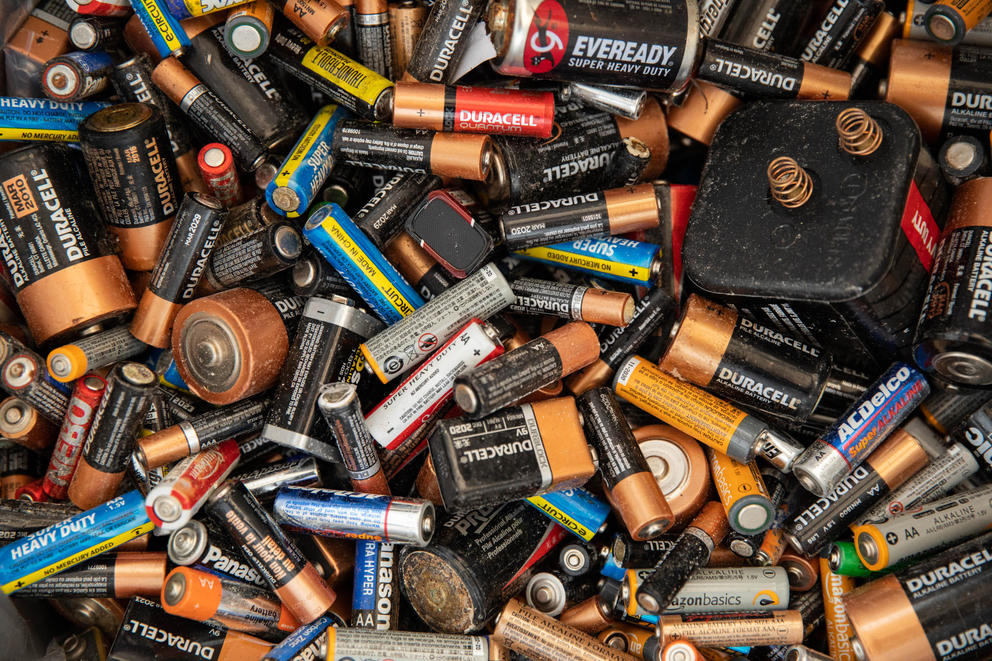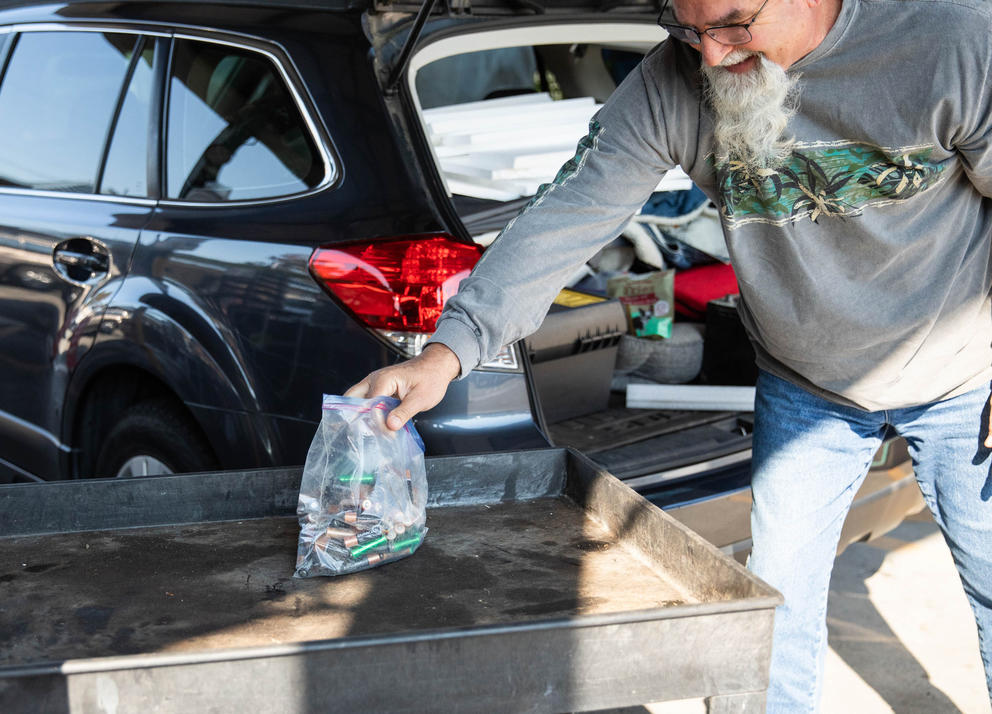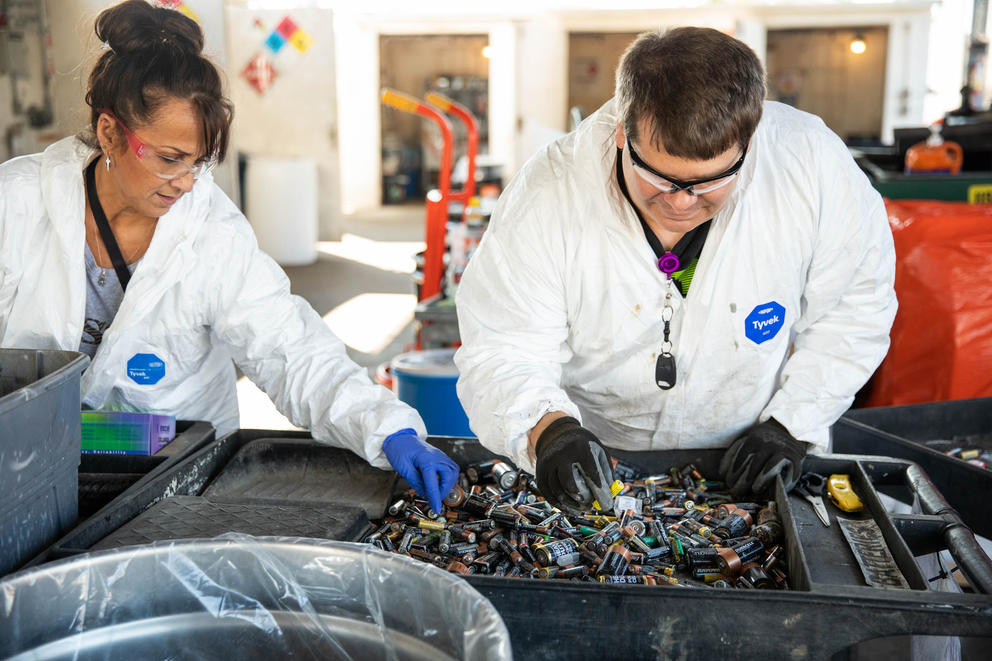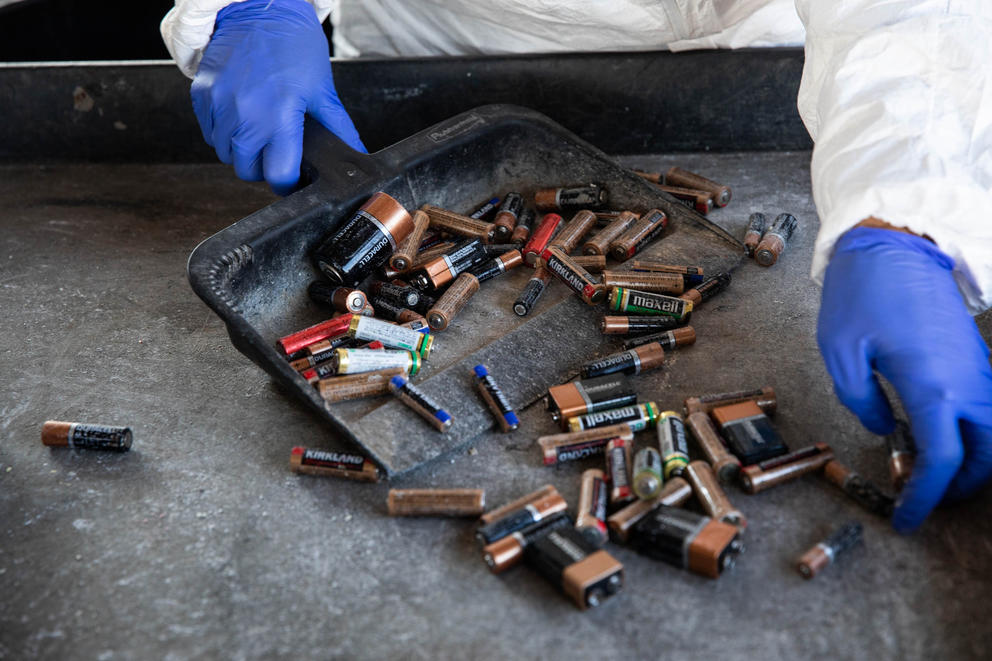“We can’t put these with other batteries because it might cause a fire,” said the environmental field site specialist, standing amid drums and boxes full of battery waste at the North Seattle Hazardous Waste Facility. The collection site on Stone Avenue North, sandwiched between Aurora Avenue North and Haller Lake and decorated with whimsical frog statues, is one of four sites in King County where county residents can regularly drop off hazardous waste, including batteries.
More people are using batteries as battery-powered tools become bigger parts of our lives, from laptops to electric vehicles promising to release us from the grip of fossil fuels. But anything that holds a charge will ultimately need to be carefully disposed of. Rechargeable batteries like nickel, lithium-ion, and lead batteries can be recycled into silverware, pots and pans, stainless steel and even new batteries. Single-use alkaline and lithium batteries can also be recycled into steel, with the former ending up in products as varied as road asphalt and sunscreen.
This creates more opportunities for people to dispose of batteries improperly, polluting the environment and putting waste processors’ health at risk.
Many batteries can be recycled with the help of people like Currie and his colleague Diana Doyle. Recycling enables the reuse of metals and critical minerals such as lithium, cobalt and nickel that are in increasingly short supply and often inhumanely acquired.
“I see people wanting to do the right thing, often,” Doyle said. “A lot of times they’ll bring, literally, bless their heart, one battery in… from five miles away.”
But many people don’t know how, or don’t have the resources, to dispose of batteries correctly. People involved in King County recycling and hazardous waste management as well as environmental advocates worry that the existing county and state systems and voluntary manufacturer take-back efforts just can’t keep up with demand in a safe way. Consumers need more help to dispose of their batteries safely, cheaply and equitably.
“We’re making all these really amazing strides to help us and to improve our environment. And we’re now realizing that those strides have some consequences, such as we really don’t have a system set up to handle all these battery-containing products that we are now creating,” said Tristen Gardner, who works on battery policy for the county.
A big boost in battery use — and potential harm
King County collects hazardous waste from at least 2.1 million residents and 60,000 businesses across 38 cities, unincorporated areas and two tribal nations, and has collected batteries for at least 15 years. In 2019, the Hazardous Waste Management Program collected 90,000 pounds of batteries from households and 4,000 pounds from businesses. Household batteries make up nearly 18% of King County’s hazardous waste collection.
Gardner said about 200,000 pounds of batteries were properly disposed of in 2020. It’s tough to say how many batteries are used in King County, which would give a better idea of proper disposal rates.
The county estimates 914,000 pounds of household single-use and rechargeable batteries were sent to Cedar Hills Regional Landfill in 2019 — about three times as much as in 2011, when 296,000 tons were sent there.
At the state level, the Department of Ecology reports that between 2016 and 2021, hazardous waste facilities working with households and small businesses collected 31% more batteries. “The amount of batteries in the waste stream is too small to detect any trends. But we know the use of batteries in consumer goods is growing exponentially,” said Ecology’s Dave Bennett.
That increase puts battery management “close to the top” of concerns for people thinking about recycling and product stewardship, said Adrian Tan, policy and market development manager for the King County Solid Waste Division. Based on what his colleagues see at landfills, people aren’t disposing of batteries well.
A big reason for concern is that batteries can start fires at waste transfer stations, in landfills or even in the backs of trucks, putting employees at risk and requiring taxpayer funds to clean up, Tan said. As batteries jostle and get compacted, they can explode and ignite — especially those rechargeable batteries that aren’t supposed to go in the trash or curbside recycling bins.
Ecology doesn’t track fire incident data at transfer stations, trucks or waste facilities, but at least eight recent Washington fires were likely caused by batteries. An EPA study published in July 2021 mentions a few: In April 2018, a hoverboard battery in the back of a Bellevue-area garbage truck ignited in transit, prompting the driver to dump the whole load in the middle of the street. A 2018 lithium-ion-linked fire at Simon Metals in Tacoma led to around $100,000 in damage and required seven firetrucks to manage. Just this month, a fire broke out at a Seattle-area transfer station that is still under investigation but was linked to batteries, Gardner said. For their part, the county has purchased FireRover infrared monitoring systems to identify battery fires in facilities.
Battery chemicals could also damage the environment. Landfills are concerned about the leakage of corrosive, toxic materials into waterways where salmon swim, for example.
Recycling batteries is complicated
To correctly dispose of a battery in King County, people have a few options — all requiring time, cost and effort. And the process is complex, because different batteries require different disposal methods.
Tan points to the Seattle-based waste collection company Ridwell. “We’re seeing programs like Ridwell, which is a private company, [serving people who] pay to get additional materials collected, and people are willing to do that. This, of course, isn’t accessible for everyone. It’s expensive… but I think it goes to show that people want to do the right thing… but we’re not able to provide the services to the level that the residents would like to see."
Ridwell’s Caleb Weaver said a 6-year-old’s questions about how to recycle batteries were the initial spark that led to the launch of Ridwell. They have recycled hundreds of thousands of pounds of batteries since then. “Today, batteries remain one of the most frequently used categories in our service,” he said.
All batteries are recyclable to a degree, but not all municipalities have set up systems for battery recycling. King County accepts car batteries, button cell batteries, alkaline batteries, lithium batteries, lithium-ion batteries (a form of rechargeables), hearing-aid batteries and more at its four permanent hazardous waste collection sites: North Seattle near Shoreline, Auburn, Factoria and South Seattle near South Park. A roving “wastemobile” spends a few days at a time in different locations throughout the county.
These facilities are all drive-up. Technicians meet you at your car and help you unload your materials while giving you additional tips on how to dispose of batteries if required. At least one of these sites is open every day from 9 to 5. Sorting batteries from fuel canisters, paint cans, fire extinguishers and more is no small task, and is done by hand. Doyle, Currie and their colleagues are adept at identifying them, dumping them onto rolling carts and sorting them like a toxic Halloween candy haul. Unlabeled batteries get handled with the most careful treatment.
“You’re just picking every little lithium battery out of there because we need to reserve it because we’re running out of lithium,” Doyle said. Damaged batteries are placed in special shipping containers; alkaline batteries are picked up by a hazardous waste company and taken to a local steel company for recycling.
If time or transit access make a drop-off difficult in Seattle, you can schedule a special item pickup through Seattle Public Utilities. But pickups must be coordinated through the utility account holder — creating another hurdle for many renters — and cost between $5 and $20 depending on how many batteries you have.
For people 65 or older, those with disabilities or those without a vehicle, the county offers a home collection program. Pickups are scheduled, usually Wednesdays between 9 and 3, and the county advises that there may be backlogs.
Battery manufacturer advocates set up their own voluntary stewardship program, Call2Recycle, more than two decades ago. More than 200 manufacturers pay for a program that makes rechargeable battery collection (and single-use, in some places) easier and less costly for consumers. Companies that sell battery-containing products have volunteered to offer no-cost battery take-backs at their physical locations. Call2Recycle lists about three dozen locations in the King County area — mostly hardware stores like Home Depot and Lowe’s — that accept rechargeables, single-use batteries, cellphones and, newly, e-bike batteries.
Gregg’s Cycles Greenlake store manager Leif Thorsen said the company joined Call2Recycle after many e-bike manufacturers whose products it sells joined the program. They’re not seeing many batteries returned to the store yet, but want people to know the option is there. “Honestly, it feels like it’s kind of in the early stages. … [we’re] talking to consumers that are buying them now and letting them know that there’s a place [for their batteries] down the road,” he said.
Companies that have take-back programs might not have them in accessible places. When Heather Trim with Zero Waste Washington went to a hardware store to find one, she had to ask an associate where the take-back box was. “It was hidden way behind a desk. … It was definitely not obvious,” she says.
King County has been contracting with Call2Recycle since 2003 to recycle rechargeable batteries collected and sorted at hazardous waste sites. The company has even been piloting a program with for-profit Ridwell for at-home battery collection, to see if it increases Call2Recycle collection rates. Ridwell picks up alkaline, rechargeable, and even hearing aid batteries as part of its paid-for service every two weeks, from $12 per month.
In the past five years, Call2Recycle has collected almost 580,000 pounds of batteries from King County and 1.18 million pounds in Washington overall, shuttling used batteries to sorting facilities and processors around the country. “Out of all of those, there’s nothing that ends up in landfills,” says Linda Gabor of Call2Recycle. “Everything that we can recover gets recovered. And 100% of those batteries are recycled that come in."
Because manufacturers take on much of the recycling costs, consumers often end up paying higher prices. Thorsen says that e-bikes include a $15 environmental recovery fee.
Batteries put in trash or recycling bins wind up at Cedar Hills. King County contracts with specialized waste management companies that attempt to reuse or recycle them.
Gabor says that consumers who live in places without single-use battery recycling options can pay Call2Recycle for collection boxes that get picked up.
What can we do?
Snowballing battery usage has charged up the county and other government collaboratives like the Northwest Product Stewardship Council (co-chaired by Tan) to work with legislators on bills establishing a statewide battery stewardship program that makes battery manufacturers responsible for safe disposal.
“It would be fantastic if you could make it easier,” said Diane Jackson, a Ballard resident who recently dropped off batteries at the North Seattle hazardous waste collection site. “I think more people would use it. I can imagine how many go in the garbage.”
Gardner says collection and battery use are an environmental justice issue. “Right now for people who have the privilege and ability to get Teslas, to get lithium-ion batteries, to be able to turn all of [their] gasoline tools to batteries… We’re the ones putting pressure on our local systems. And it’s not fair for everyone else,” Gardner says.
According to a 2012 survey of nearly 2,000 King County residents, hazardous waste collection sites are visited disproportionately by people who live in single-family homes, own their homes, identify as white, and earn higher incomes except for above $150,000.
Dave Bennett with the Department of Ecology says a good battery stewardship program would help residents and governments by standardizing battery recycling, and improving equitable access to battery collecting and recycling services that are safe and free to consumers. They would ideally accept all battery types so consumers don’t need to wonder if they’re putting the right one in the right place. The program would be paid for by battery manufacturers. And the government would design a system that completely separates battery recycling from other solid waste disposal, hopefully preventing fires and environmental impact from leaking batteries.
“We’d also have much more transparency about how much is actually reused and recycled,” Tan said.
States like Vermont and the District of Columbia have established battery stewardship programs, and California passed a bill creating a program just this month. Washington state representatives have introduced battery stewardship legislation at least three times since 2013, but none have passed. There’s precedent for a program like this in Washington, which has product stewardship programs for products like paint and e-waste like TVs and computers.
Battery stewardship proponents are pushing for an all-battery solution: All batteries would require the same consumer action at the end of their useful lives, reducing confusion.
“To the average person, a battery is a battery is a battery. So if you put a double-A alkaline next to a double-A lithium-ion, it’s very, very hard for anybody who’s not trained to differentiate … between the chemistries, and so the easier that I think you can make it, the better the recycling rates are,” Call2Recycle’s Gabor said.






